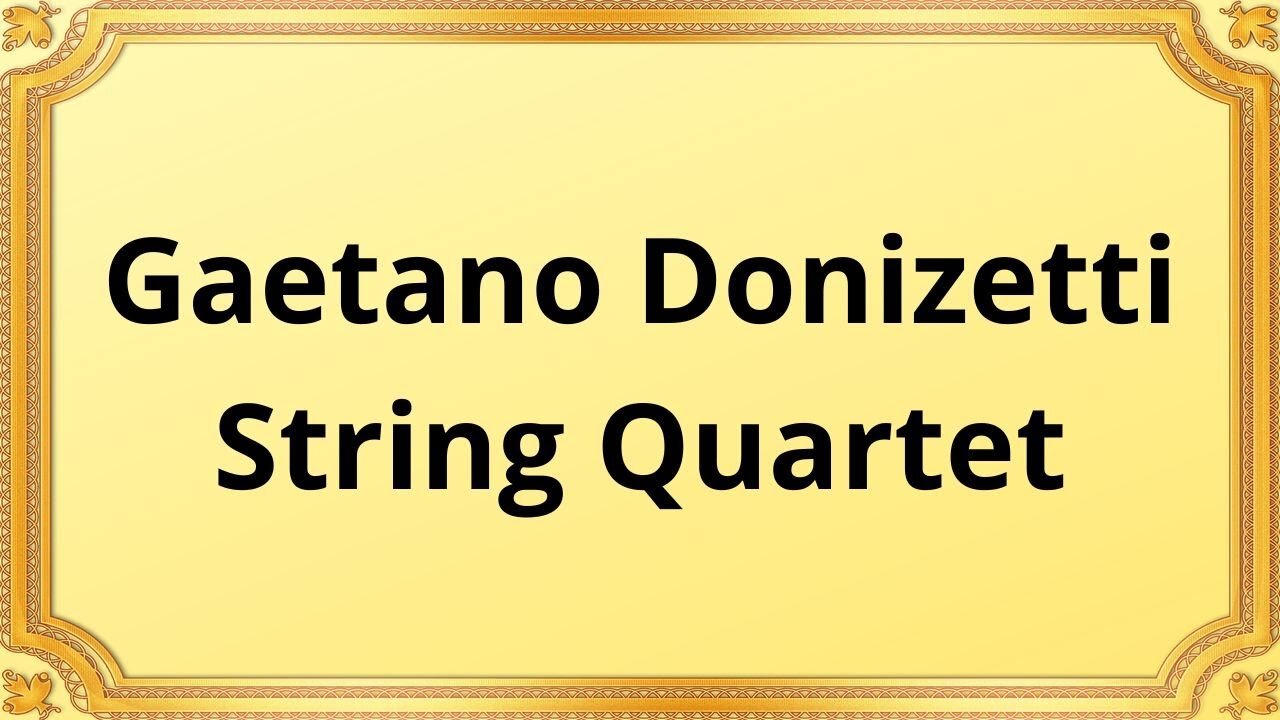Premium Only Content

Gaetano Donizetti String Quartet No. 5 in E Minor
#ClassicalMusic #GaetanoDonizetti #StringQuartetNo5 #EMinor #Composition #ChamberMusic #ItalianComposer #19thCenturyMusic #StringQuartet #Opera #ItalianOpera #RomanticEra #MusicalMasterpiece #Melodic #Emotional #Virtuosic #ItalianClassicalMusic #DonizettiLegacy
Violins: R. Plantevin and M. Mercanton,
Alo: A. Vauquet,
Cello: F. Courvoisier
Gaetano Donizetti, a renowned Italian composer of the 19th century, is celebrated for his contributions to the world of opera. However, his musical genius extended beyond the realms of opera, and one notable example of his brilliance in chamber music is his String Quartet No. 5 in E Minor.
Composed during the Romantic era, the "Gaetano Donizetti String Quartet No. 5 in E Minor" stands as a testament to Donizetti's versatility and skill as a composer. This piece, although lesser-known compared to his operatic works, is a musical masterpiece that showcases his melodic inventiveness, emotional depth, and virtuosic writing.
The quartet is scored for two violins, viola, and cello, adhering to the traditional string quartet ensemble. As the piece begins, the listener is immediately captivated by the haunting and melancholic atmosphere created by the E Minor key. Donizetti expertly weaves together intricate melodic lines, interplay between the instruments, and moments of harmonic tension and release throughout the composition.
The first movement, marked Allegro moderato, introduces the main thematic material, which undergoes various transformations and developments as the movement unfolds. Donizetti's compositional skill is evident in his ability to seamlessly transition between contrasting moods and musical ideas, effortlessly keeping the listener engaged and intrigued.
The second movement, marked Andante cantabile, offers a moment of respite and introspection. Here, Donizetti's gift for crafting beautiful melodies shines through. The music is deeply expressive and contemplative, inviting the listener to embark on an emotional journey.
The third movement, marked Menuetto, returns to a more lively and rhythmic character. It features a playful and energetic theme, expertly passed between the instruments, creating a sense of joy and camaraderie among the musicians.
The final movement, marked Allegro vivace, brings the quartet to a spirited and exhilarating conclusion. Donizetti showcases his virtuosic writing skills, incorporating fast-paced passages, intricate counterpoint, and moments of dazzling brilliance. The movement builds to a thrilling climax, leaving the listener with a sense of awe and admiration for Donizetti's compositional prowess.
While Donizetti may be primarily known for his operatic works, his String Quartet No. 5 in E Minor demonstrates his ability to create captivating and emotionally charged music beyond the opera stage. This composition stands as a testament to Donizetti's legacy as a versatile and talented composer in the realm of classical music. Its melodic beauty, emotional depth, and virtuosic writing continue to captivate audiences and deserve recognition as a significant contribution to the genre of chamber music.
In conclusion, Gaetano Donizetti's String Quartet No. 5 in E Minor is a musical gem that deserves appreciation. Its melodic inventiveness, emotional depth, and virtuosic writing showcase Donizetti's mastery as a composer. Whether you are an avid classical music enthusiast or a newcomer to the genre, this quartet is bound to captivate and leave a lasting impression.
You have the opportunity to support the channel:
https://destream.net/live/RadSiarAl/donate
https://www.buymeacoffee.com/6355radsiaral
-
 6:18
6:18
Classical music_Music Inspiration
4 days agoTomaso Albinoni Concerto in C major, No. 2, Op. 5
241 -
 14:14
14:14
Robbi On The Record
8 hours ago $4.77 earnedThe Identity Crisis No One Wants to Admit | Identity VS. Personality
18.2K4 -
 31:10
31:10
The Why Files
4 days agoThe First Earth Battalion: America's Strangest Military Experiment
61.4K28 -
 4:18:02
4:18:02
SpartakusLIVE
10 hours ago#1 Pilgrim of PAIN Gives Thanks HAPPILY as he DESTROYS Enemies and BAGS LOOT
176K7 -
 59:47
59:47
iCkEdMeL
10 hours ago $43.54 earnedBREAKING: National Guard Soldier Dies + New Video Shows Suspect Opening Fire
36.3K40 -
 1:20:38
1:20:38
Flyover Conservatives
1 day agoThanksgiving’s Hidden History: Islamic Pirates, Spanish Threats, and Socialism - Bill Federer | FOC Show
43.7K5 -
 25:43
25:43
Russell Brand
1 day agoThis Is Getting Out Of Hand
139K151 -
 LIVE
LIVE
The Quartering
18 hours agoThanksgiving Day Yule Log!
1,337 watching -
 15:32
15:32
IsaacButterfield
1 day ago $6.26 earnedAussie Reacts To UNHINGED Woke TikToks!
31.1K11 -
 3:24:28
3:24:28
PandaSub2000
18 hours agoNintendo Platformers - Thanksgiving 2025 Special | ULTRA BEST AT GAMES (Original Live Version)
49.9K8